If you want to learn how to start a call center, the first thing you should do is have a clear plan before diving in.
It doesn’t have to be expensive or complicated, but you need to consider several key factors to deliver an excellent customer experience and run a successful call center business:
- Identify your niche
- Understand the technology
- Stay compliant with regulations
- Prioritize customer experience
In this guide, we’ll walk you through these steps and more, so that you have all the information you need to set up a productive and profitable call center operation.
8 Steps to Starting a Successful Call Center
Here’s a breakdown of the eight key steps on to how to start a call center business to ensure a smooth launch and a successful ongoing operation.
1. Choose your call center type
The first thing to figure out is where your team will be calling from. Here are the most common type of call centers:
On-Premises Call Center
This is a call center that’s in a physical building and is traditionally set up.
- Advantages: Full control over the environment (systems, data security, customization)/
- Challenges: High upfront costs for office space, equipment, and ongoing maintenance.
Virtual Call Center
Call center representatives work remotely from various locations and are connected through cloud-based technology.
- Advantages: Lower costs, easier scalability, and ability to hire talent globally.
- Challenges: Unreliable internet connection, data security concerns, and potential difficulties in managing remote teams.
Work-from-Home Call Center
Like a virtual call center, it focuses on agents working from home.
- Advantages: Flexibility for workers, reduced costs for physical space, and scalability.
- Challenges: As with virtual call centers, challenges include unreliable internet connections, data security concerns, and difficulties managing remote teams.
Inbound Call Center
Receives incoming calls from customers about customer service (billing issues, plan changes, returns) or technical support.
- Advantages: Tailored to support customers, often improving customer satisfaction and retention.
- Challenges: Must handle potentially high call volumes, requiring efficient call center agent training and scheduling.

Outbound Call Center
Call agents primarily make outbound calls, often for telemarketing, sales, surveys, or debt collection.
- Advantages: Effective for lead generation, proactive customer outreach, and business development.
- Challenges: Can face strict regulations (e.g., do-not-call lists), and customers may view outbound calls as intrusive.
Blended Call Center
Combination of inbound and outbound call center functions.
- Advantages: Efficient use of resources, as agents can switch between tasks (customer inquiries and sales calls) based on demand.
- Challenges: Requires agents to be skilled in both inbound and outbound communication.
Automated Call Center
Uses advanced technologies like interactive voice response (IVR), artificial intelligence (AI), and chatbots to handle most types of customer interaction without the need for human agents, or to assist human agents.
- Advantages: Reduces labor costs by automating routine tasks, provides 24/7 customer support, and shortens wait times by offering self-service options.
- Challenges: May frustrate customers who prefer human interactions, and requires significant investment in technology and integration.
Offshore Call Center
Call center operations are outsourced to a different country where labor costs are lower.
- Advantages: Cost savings, access to a larger workforce, and round-the-clock service due to time zone differences.
- Challenges: Cultural differences, potential language barriers, and concerns about service quality.
Omnichannel Call Center
Integrates multiple communication channels (phone, email, live chat, social media) into a single platform, allowing agents to seamlessly switch between channels while interacting with customers.
- Advantages: Provides a unified, consistent customer experience across all channels, which improves efficiency.
- Challenges: Requires advanced software, training, and may be more complex to manage.
Multichannel Call Center
Similar to omnichannel, but the channels (phone, email, chat, etc.) are managed separately, with less integration.
- Advantages: Customers have multiple ways to reach the business.
- Challenges: Lacks the seamless experience of omnichannel, as agents may not have a full view of the customer’s interactions across channels.
So, which one’s right for you? It all boils down to your priorities. For example:
👉 If you want more physical control and have the budget, an on-premise call center might work.
👉 Virtual call center software is ideal for budget-conscious small businesses and startups seeking flexibility, including the ability to have agents across different time zones.
👉 And if you want to provide a seamless customer experience across multiple channels, then an omnichannel contact center could be the way to go — whether you build an in-house team or outsource to a call center company.
Evaluating contact centers? Get the buyer’s guide.
This guide reveals the five pillars of a modern platform, key questions to ask, and red flags to avoid.
Related: Call Center Outsourcing: A Go-To Resource for Outsourcing
2. Define your call purpose and goals
Now take a moment to define your call center’s purpose and set some clear goals. This will be your business plan to success.
First things first, decide what kind of calls your center will handle.
Inbound call centers are those where customers reach out to you for help (think troubleshooting or order inquiries). Outbound call centers involve your team reaching out to others (like for sales, telemarketing, or market research). A blended center tackles both inbound and outbound operations.
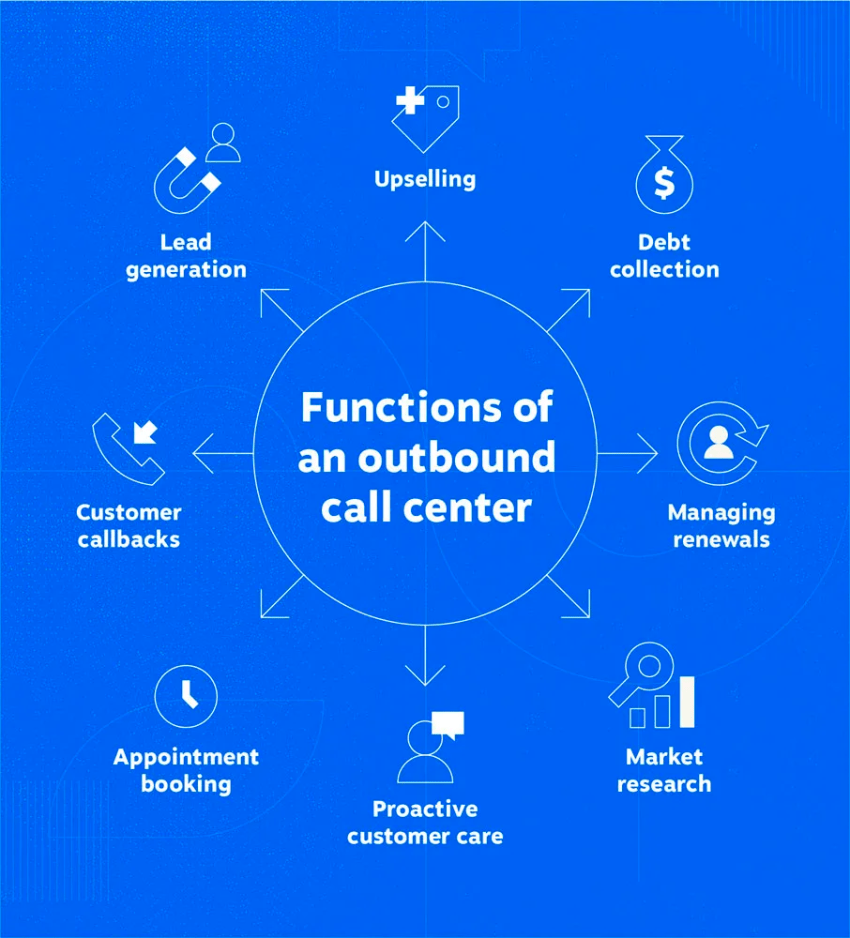
Next, determine the services you’ll offer. Will your call center focus on customer support, sales, technical support/help desk, or a combination of these? Knowing your service focus will help you decide who to hire and how to structure your operations.
Vague goals like “be awesome” won’t cut it. Set Specific, Measurable, Achievable, Relevant, and Time-bound goals (SMART goals for short). This could involve setting customer service goals like high customer satisfaction rates, faster call resolution times, or exceeding sales targets.
💡 Tip: Do your research. See other call center companies and industry benchmarks for metrics like average handle time (how long a call typically lasts) and first-call resolution rate (how often an issue is solved on the first call). This will help you set realistic goals for your own call center.
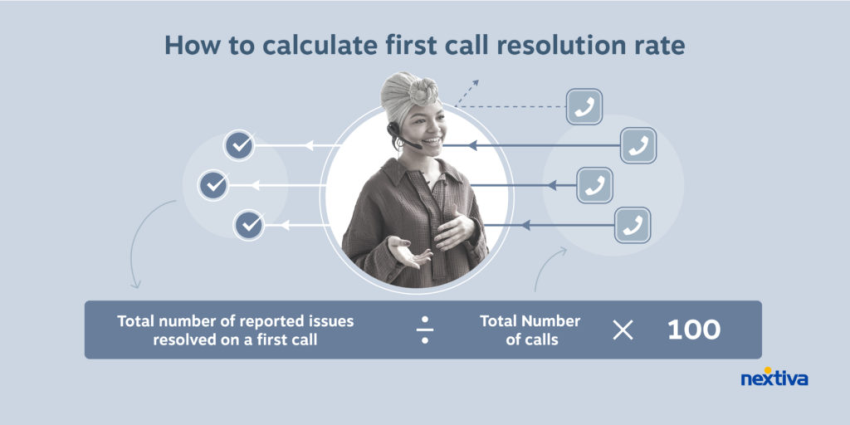
3. Plan your budget
Building a sustainable call center requires careful budgeting, so be smart with your money.
So how much does it cost to start a call center business? This can vary widely depending on the type of call center, size, and location. But to give you a few examples:
- Inbound Call Center: Start-up costs can be around $5,000 including hiring staff, renting space, and purchasing equipment.
- Outbound Call Center: Start-up costs can be around $10,000, which includes most of the same things as inbound (hiring staff, renting space, and purchasing equipment).
- Blended Call Center (Inbound & Outbound): Start-up costs can be around $15,000, which includes the same things as inbound and outbound (hiring staff, renting space, and purchasing equipment).
- On-Premise Call Center: For a small- to medium-sized on-premise call center, the set-up cost might range from $10,000 to $50,000, covering equipment, software, and infrastructure. approximately $15,000 to over $50,000, depending on the scale and specific needs.
- Cloud-Based or Virtual Call Center: The upfront costs will be lower than on-premise, and can range from around $1,000 to $13,000, depending on the service provider and scale.
And then there are the ongoing monthly expenses, including:
- Equipment: You’ll need reliable phone lines, phone numbers, and business phone systems to keep both outgoing calls and incoming calls flowing smoothly, not to mention dedicated computers and laptops for your call center agents. Hardware like phones and headsets can run about $50 each, while computers or laptops can be anywhere from $300-$2,000.
- Technology: Call center software with features like automatic call distribution (ACD for smart call routing) and interactive voice response (IVR for letting customers solve simple issues themselves) are also essential. Call center software is about $120 per user per month, and network infrastructure (routers, firewalls, etc.) costs around $2,000.
- Physical office: If you’re setting up a physical call center, factor in renting or buying office space, furniture, supplies, and utilities. (Even virtual setups require comfortable workstations and headsets for your agents.) Renting a small call center office can be around $2,500 per month.
- Employees: Salaries, benefits, and training for your staff all need to be budgeted for. The average (this includes entry-level to experienced) call center agent salary is about $31,200.
We estimate that the staffing cost for a 20-person call center is about $694,000 annually.
💡 Tip: Get quotes from different vendors for everything from phone systems to call center software and headsets. Consider cloud-based solutions — they can be more scalable and potentially save you money in the long run.
4. Choose the right technology
The right tech keeps your agents happy and productive and enhances your customer experience. Now that you’ve got your strategy figured out, it’s time to deck out your call center with the right technology:
- A reliable business phone system: Invest in a dependable Voice over Internet Protocol, or VoIP phone system. This will ensure that your agents and customers can hear each other loud and clear, no matter where they are.
- Call center software: It’s your call center’s brain. Choose a cloud call center to minimize the hassle of maintaining costly infrastructure. Look for features like automatic call distribution, IVR, call recording for training and quality control, and even performance management tools to track agent progress. Software that integrates with your Customer Relationship Management (CRM) system is also a plus for seamlessly managing customer data.
- Workforce management tools: Consider using workforce management tools to streamline scheduling and optimize staffing levels in real time based on call volume.
- Agent essentials: Provide your agents with high-quality computers, automated tech like predictive dialers, noise-canceling headsets for clear audio, and comfortable workstations to energize them throughout their shift.

💡 Tip: Don’t go overboard with complicated software. Choose something scalable to fit your needs and easy for your agents to learn. Many vendors like Nextiva offer demos, so take advantage of those to test-drive the software before you commit.
5. Build your team
Your call center is only as good as the people working in it. That’s why building a fantastic team is crucial. Here’s how to make it happen: When recruiting call center agents, target those with exceptional communication skills — they should be able to explain complex things clearly and listen attentively to customer needs.
Problem-solving skills are a must too, and a natural knack for providing friendly and helpful customer service is the cherry on top. Look for candidates with experience in similar roles like cold calling or those who seem to have a natural ability to connect with people.
Once you’ve assembled your dream team, equip them with the knowledge they need to perform better. Develop a comprehensive training program that covers everything from in-depth product knowledge to call center best practices.
Agents should also understand your call center’s workflows and protocols inside and out. Have a knowledge base handy and easily accessible for them.
Employees should feel valued and supported when working in your call center. To keep your team motivated and improve agent retention, create a positive work environment with opportunities for growth and development.
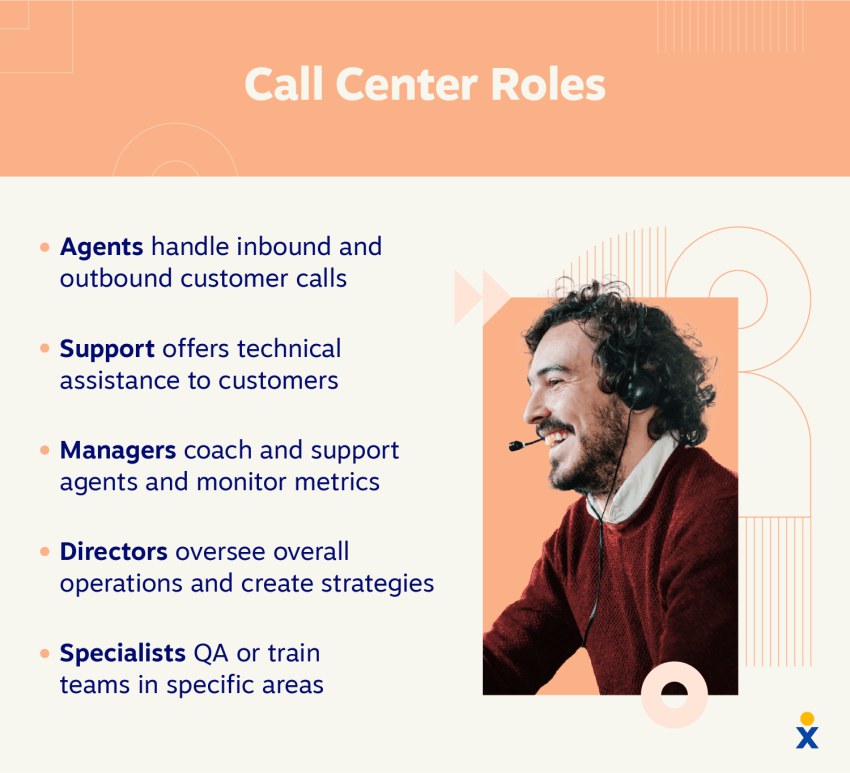
💡 Tip: Don’t stop learning once the initial training is done. Invest in ongoing coaching and development programs to sharpen your agents’ skills. Consider using gamification techniques (think points and contests!) to make learning fun and motivate your team.
6. Design efficient workflows
Streamlined workflows are key to consistent, high-quality service.
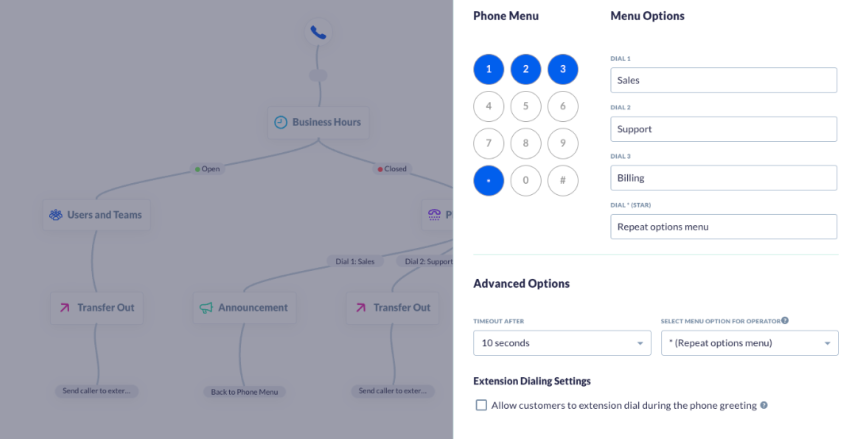
Here’s how to create a system that keeps your call center running smoothly:
- Clear call scripts and protocols: Develop standardized customer service scripts and protocols that act as a roadmap for your agents during customer interactions. This ensures a consistent approach and equips your team to confidently handle any situation.
- Performance metrics and KPIs: Keep your finger on the pulse of your call center’s performance by tracking key call center metrics. This could include average handle time (how long a call typically lasts), first call resolution rate (how often an issue is solved on the first call), and customer satisfaction scores. By analyzing this data, you can identify areas for improvement and ensure your agents exceed customer expectations.
- Quality monitoring and coaching: Call recording is a powerful tool. Use it to monitor call quality and provide constructive feedback to your agents during coaching sessions. This will help them identify areas for improvement and continuously hone their skills.
- Continuous learning: Ongoing learning is essential for a thriving call center. Develop training programs to keep your agents’ skills sharp and encourage knowledge-sharing initiatives amongst your team.
💡Tip: When designing your workflows, remember your customers. Gather their feedback and, based on their suggestions, find ways to streamline processes and reduce wait times. After all, a happy customer is a loyal customer.
7. Promote your call center services
Alright, your call center is up and running smoothly. Now it’s time to get the word out there and attract potential customers who need your services. Let’s look at a few ideas:
- Target the right clients: Identify your target clients. Once you have a clear picture, focus your marketing efforts on reaching those businesses. They’ll be the ones who truly appreciate the value you bring.
- Craft a compelling message: What makes your call center special? Do you have a knack for resolving customer issues quickly? Do your agents go the extra mile to provide exceptional service? Highlight your unique strengths and value proposition in your marketing materials.
- Get online and get active: The internet is a goldmine for reaching new customers. Consider online advertising, targeted email campaigns, or even creating informative content (like blog posts or videos) that showcases your expertise. Don’t forget social media — join relevant industry groups and participate in conversations to build brand awareness.
- Events and partnerships: Industry events are a fantastic way to network with potential clients and partners. Showcase your services at trade shows or attend conferences where your target audience gathers. Partnering with complementary businesses in your industry can also expand your reach and generate leads through referrals.
💡 Tip: Speaking the same language as your clients is key. Tailor your marketing messages to their specific needs and challenges. For example, if you’re targeting e-commerce businesses, highlight your experience in handling high volumes of customer inquiries during peak seasons.
Related: 5 Must-Attend Call Center Conferences in 2024–2025
8. Continuously monitor and improve
Launching a call center is a big accomplishment, but it grows over time.
Regularly analyze call center metrics to see what’s working well and where there’s room for improvement. Is your average handle time a little high? Are customers dropping off during phone calls? These metrics can point you in the right direction for improvement.
Don’t be afraid to adapt your workflows based on what you learn. Customer feedback is important too – listen to what they’re saying and use it to refine your processes. Industry best practices are constantly evolving, so stay up-to-date and be open to incorporating new strategies.
It’s good to keep an eye on the latest call center technologies and see how they can benefit your business. Maybe it’s a new kind of software that automates repetitive tasks or a tool that uses AI to personalize the customer experience. Embrace new tech that can give you an edge.
Where does your CX strategy stand with AI?
Take the AI Maturity assessment to get personalized recommendations on how to enhance your CX.
Last but not least, create a culture that encourages continuous improvement. Call center managers should hold regular team meetings to discuss call center metrics and get feedback from their agents. They’re on the front lines interacting with customers every day, so their insights are valuable. New ideas are always welcome — you never know what you might discover.
💡 Tip: Schedule regular team huddles to discuss performance metrics and brainstorm improvement ideas. This is a great way to keep everyone engaged and motivated to reach new heights.

Key Call Center Challenges (+ How to Overcome Them)
Even the most meticulously planned call center can face challenges. Consider common roadblocks and navigate them to efficiently set up your call center.
1. Recruiting and retaining top talent
One big challenge is finding and keeping good staff. The call center industry has a high turnover rate.
Offer competitive pay and benefits, along with opportunities for career growth. Create a positive work environment that values employees’ well-being and work-life balance.
You can also use gamification and recognition programs to keep agents motivated. When you advertise for new hires, highlight your company culture and career development opportunities.

2. Maintaining high call center agent morale
Repetitive tasks, lots of calls, and frustrated customers can lead to call center burnout.
Empower agents by giving them some control over their work and the ability to solve problems, not just follow scripts. Let them take breaks and offer schedule flexibility.
Celebrate successes and recognize both individual and team achievements. Regularly ask agents for their feedback to see how things are going and what can be improved.
3. Delivering exceptional customer service
It can be tough to meet customer expectations, especially when dealing with complex issues or upset callers.
Provide agents with in-depth training on your products or services, as well as effective communication and de-escalation techniques. Help them resolve issues efficiently by focusing on first-call resolution rates.
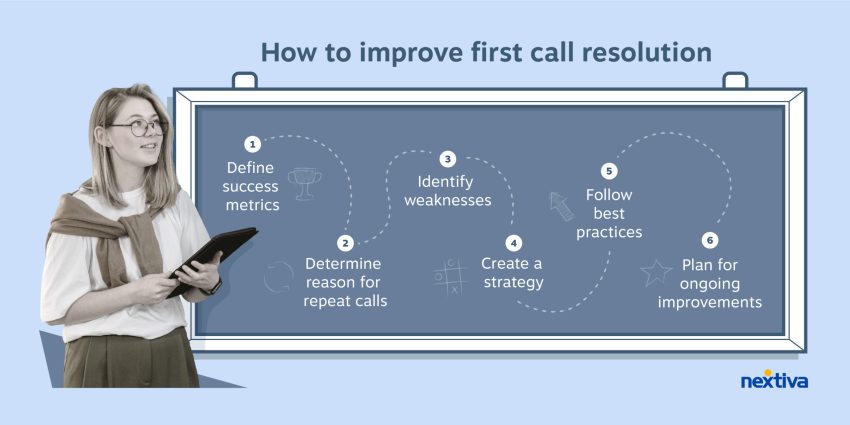
Ask customers for feedback regularly and use it to improve your service approach. Empower agents to offer small gestures of goodwill to resolve customer issues and create a positive experience.
4. Keeping up with technology
The call center landscape is constantly changing, with new tools and systems emerging constantly. Staying ahead of the curve can be expensive and time-consuming.
Set aside a budget to regularly evaluate and implement new technologies. Consider cloud-based solutions that are easy to scale and upgrade.
Encourage a culture of innovation and empower agents to suggest new technologies that can improve efficiency or customer experience.
Make sure to partner with a reliable call center technology vendor who can provide smooth onboarding, ongoing support, and guidance.
5. Adapting to changing customer needs
What customers want and how they want to connect with you constantly evolve. If your call center doesn’t adapt, customer satisfaction takes a hit.
For example, millennials are more likely to use text messaging than wait in a call queue. Likewise, if your business serves the elderly, it’s a safe bet that they’re less likely to contact you via social media channels than making a phone call.
Offer omnichannel support so customers can connect with you through their preferred channel, whether it’s phone, email, chat, or social media.
Customer feedback through surveys and social media monitoring helps you understand customers’ evolving needs and preferences. Be prepared to adjust your service offerings and communication strategies accordingly.
Also, train agents to handle inquiries across multiple channels and provide a seamless customer experience regardless of how a customer chooses to connect.
It Starts With the Right Call Center Software
Launching a call center doesn’t have to be hard. Historically, it used to involve weeks — or even months — of installation long before the first call arrived.
Now, with the power of cloud-based communications, you can set up a new call center in hours. After you plan call flows and team workflows, the rest is a breeze.
When you start a call center, top features include:
- softphones
- Interactive Voice Response (IVR)
- automatic call distribution (ACD)
- skill-based call routing
- call recording
But remember to only get (i.e. pay for) features that align with your business needs. Not everyone needs all the bells and whistles when starting out.
Now that you’ve learned how to start a call center company, partner with your call center provider so they can help you achieve these goals, including helpful ideas to do it faster.
Nextiva is a top-ranked AI-powered Contact Center that helps empower agents and satisfy customers. Our award-winning customer service has earned us #1 ratings from Gartner, Frost & Sullivan, and other VoIP industry experts.
See why millions trust us daily.
Your call center solution.
For a cloud-based call center with many features that scale when you need to, check out Nextixa’s VoIP call center solution.
Call Center FAQs
Ready to start a call center? Read some of the FAQs to better inform your setup.
The decision depends on your budget and call volume. A physical call center offers a centralized workspace but requires investment in office space, furniture, and IT infrastructure. Virtual call centers are more flexible and cost-effective, with agents working remotely. They rely on cloud-based technology and require minimal upfront investment.
The type of software depends on your call center’s functionality. Essential features include automatic call distributor (ACD) to route calls efficiently, Interactive Voice Response (IVR) for self-service options, and Customer Relationship Management (CRM) integrations for agent visibility into customer data. Costs vary depending on features, number of users, and vendor. Researching and comparing pricing options from different vendors is crucial when choosing call center software.
Here’s a quick guide on call center pricing.
Data security is paramount to maintain contact center compliance. Familiarize yourself with relevant regulations (e.g., PCI DSS) and implement safeguards. Invest in secure technology, employee training on data handling procedures, and robust data encryption methods.
Here are some essential call center metrics to monitor agent performance:
– Average handle time (AHT): Measures how long a call typically lasts.
– First call resolution rate (FCR): Indicates how often an issue is solved on the first call.
– Customer satisfaction scores: Gauge customer sentiment about their experience.
– Agent performance metrics: Track individual call center agent performance (call volume, wait times) to identify areas for improvement.
Regularly analyze call center data to refine processes, improve agent training, and enhance the overall customer experience.
To start your own call center business:
– Conduct market research to identify your niche.
– Create a business plan detailing operations, costs, and target clients.
– Choose the call center type.
– Set up essential technology like CRM software, telephony, and workforce management tools.
– Hire and train staff.
– Market your services to attract clients.
Like any business, profitability depends on client acquisition, service quality, and maintaining operational efficiency. Call centers can certainly be profitable, with profit margins ranging from 10% to 30%, depending on factors like efficiency, size, and industry. Cloud-based or outsourced operations can boost profitability by reducing overhead costs.
Here are a few ways to find clients for a call center:
– Network through industry events and professional associations.
– Use digital marketing strategies like SEO, social media, and email campaigns to reach potential clients.
– Offer competitive pricing and specialized services tailored to industries like healthcare, retail, or tech support.
– Build relationships with businesses needing customer service, sales, or technical support solutions.
– Leverage referrals and case studies to demonstrate your success to potential clients.

















 VoIP
VoIP 


















